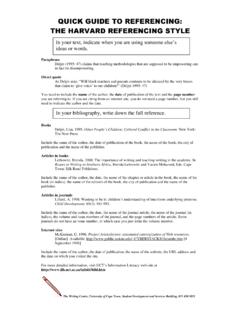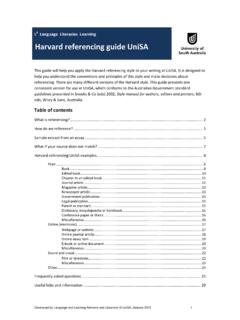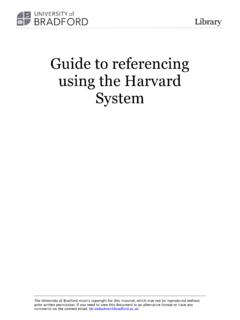Transcription of Harvard referencing - quick guide - University of Kent
1 Harvard referencing quick guide 1. What is referencing ? referencing is a system that allows you to acknowledge the sources of information you use in your writing. If you do not reference your sources, you are plagiarising. You must provide a reference whenever you quote, paraphrase or summarise someone else s ideas, theories or data. Some of the sources you need to reference include: Books or chapters in book Journal or newspaper articles Conference papers Electronic sources 2. Harvard a system not a standard The Harvard style of referencing is widely used at the University of Kent, but it is not the only style used. Always check with your tutor, course handbook or the Academic Integrity website ( ) to make sure of the style of referencing required (NB. If you re taking modules from different departments, you may well have to use more than one style of referencing in your written assignments).
2 Also bear in mind that Harvard is a system not a standard. , there is no definitive guide to the exact format of references, and different institutions, departments and different lecturers can have subtly different way of doing things. Caution should therefore be exercised in using referencing guides from other institutions. The comprehensive guide to Harvard referencing at the University of Kent is available online at Another very useful referencing guide is the booklet Cite them right which can be ordered from 3. The Harvard style of referencing The Harvard style of referencing is an author-date system whereby you insert the reference (citation) as a parenthetical author name and date within the text of your document. The in-text citation is accompanied by a full bibliographic reference in either a reference list or bibliography (or possibly both) at the end of your assignment. 4. Harvard Style Citations Examples To cite a paraphrase or a summary of the author s ideas: The theory was developed amidst much controversy (Ward 1996, p 72) or Ward (1996, p 72) states that the theory was developed amidst much controversy.
3 The author s surname links the reader to the list of references at the end of your work. Where the author cannot be identified, refer by title: Figures in a recent survey (Trends in Tourism 2004, p 12) showed To reference the overall content of a work, you do not need to include page numbers because it is the entire work you are referring to: Kaplan and Jones (2005) studied the effect of pollution in five major To cite a direct quotation: Family crisis intervention has to be on a 24 hour basis (Ward & Hicks 1997, p 6). 5. Lists of References & Bibliographies Reference List Bibliography A list of all (and only) those sources which are cited within the written assignment A list of all those sources which are cited within the written assignment PLUS Any other sources which influenced or informed your understanding of the topic but that you didn t refer to explicitly As always, check to make sure which of these is required.
4 6. Harvard Style List of references Examples A whole book: Ward, R (1996). Changes in Biochemistry. London: University College London Press. A chapter in a book: Crane, A (1991). How biochemistry changes. In: Hudson, W. and French C. eds. Living Biochemistry. Massachusetts: MIT Press, pp. 80 83. A journal article: Kaplan, J. (2008). Historical changes. Educational Psychologist. 42(6), pp. 536 9. A journal article (Online): Sutton-Smith B. and Rosenberg, (1961). Sixty years of historical change in the game preferences of American children. Journal of American Folklore [Online], 74(291), 17-46. Available from: [Accessed 2 December 2007]. Government publications: Department of Education. Annual Report 2000. HMSO, London. A website: National Health Service (2009). Swine flu [Online]. Available from: [Accessed 8 October 2009].














